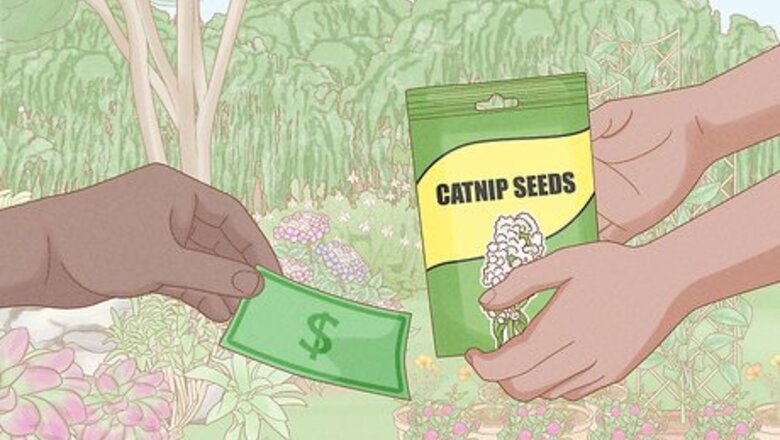
views
Growing Catnip from Seeds
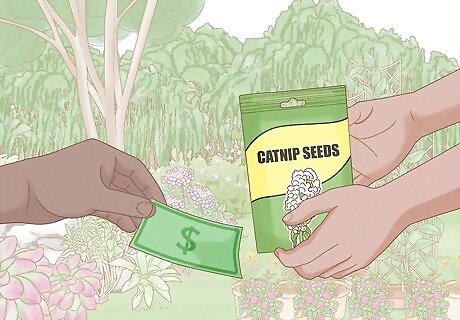
Purchase catnip seeds. Local home and garden stores carry both catnip seeds and small catnip plants ready for planting. Your local pet store might even carry seeds or plants. If you want to save money, or if you know of someone who already is growing catnip, you could ask them for a plant or some seeds.
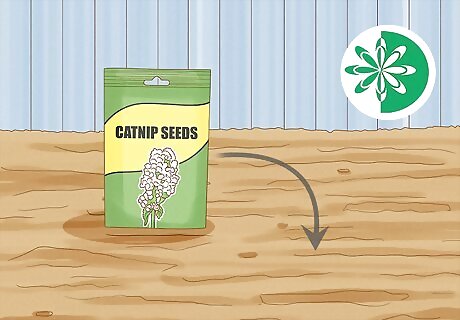
Plant seeds directly in the garden in spring. Catnip seeds can be sown outdoors only during the spring. If you’re planting seeds directly into your outdoor garden, sow them as soon as any threat of frost has passed. Bury seeds 1/8 of an inch (3.2 mm) beneath the soil and space them at least 15 inches (38.1 cm) apart. Water them well during their germination period, which lasts up to ten days. You should begin to see sprouts after this period.

Sow seeds indoors in spring or fall. If you’re sowing seeds indoors, you can plant seeds in either spring or fall. Plant them in small individual pots or in a seed trough or bed. Make sure they get enough sunlight, or they will get leggy. If you can’t provide enough sun, you can use a fluorescent lamp above them. Water them well as they germinate. If you’re sowing in the spring, grow the plants until they are 4-5 inches (10.2-12.7 cm) tall and transplant outdoors after any threat of frost has passed. If sowing seeds in the fall, grow them by a sunlit window, preferably one that will receive at least six hours of sun daily. Transplant outdoors in spring or when there is no danger of frost. Seeds sown in the fall tend to yield a denser, bushier crop of plants.
Planting Young Seedlings
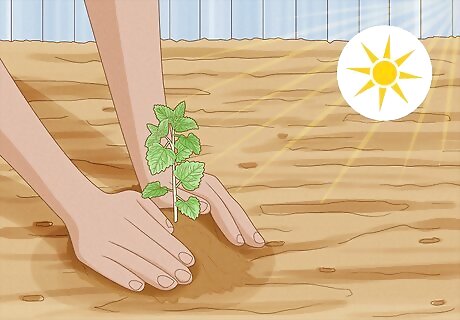
Plant in full sun, unless you live in a hot, dry location. Catnip prefers full sun in most locations. If you live in a hot, dry climate, consider an area where plants will have some shade from the afternoon sun. It will still need at least six hours of full sun, but in locations in the south, the sun at its highest and hottest could damage leaves. Catnip grows best outdoors, but can be grown indoors if you place it by a window that gets at least six hours of full sun per day. If growing a plant indoors, you should place it no more than three feet away from the sunlit window. Alternatively, you can grow it indoors away from a sunlit window if you have access to high output fluorescent plant grow lights.
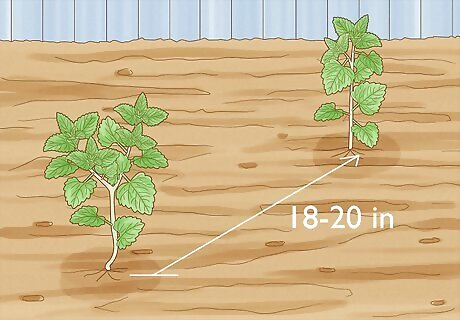
Space plants 18 to 20 inches (45.7 to 50.8 cm) apart. Use standard potting soil if you’re container planting, or whatever soil you have in your garden. Soil should allow draining, so it shouldn’t be too rich or compacted. Catnip, like most herbs, will thrive in poor soil. Give seedlings or young plants ample room to grow, leaving about 18 to 20 inches (45.7 to 50.8 cm) between each plant to prevent crowding. They might look thin when you first plant them, but they will need the room to grow and will soon fill out the space. Catnip will grow in just about any soil, but sandier soil tends to yield more aromatic plants. Water frequently after first planting. After a couple weeks, or after you see that the plants have adjusted to transplanting and are starting to grow, water only when the soil has dried out a few inches below the surface.

Consider planting in pots. Once established, catnip can grow aggressively, and can take over an entire garden. To keep it from invading your yard, grow it in a controlled garden, such as one with permanent stone dividers. If you don’t have a controlled space, using containers offers total control of where and how your catnip plants grow. If you want the look of an herb garden, but don’t want to risk catnip taking over, plant it in containers then bury the containers in your garden. Placing the plants in containers beneath the soil will help confine and control their roots, preventing them from wandering throughout your garden. Look for shoots and new spouts that might try to grow beyond the pot. Pull new shoots when you see them, and don’t place too much soil on top of the container when you’re burying it.
Maintaining and Harvesting Catnip
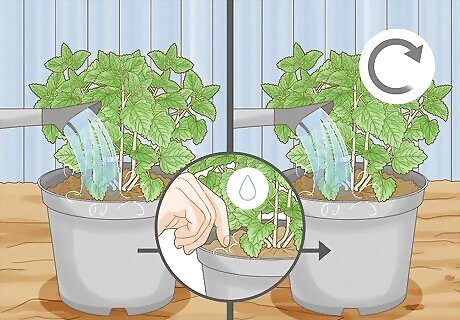
Allow soil to dry out between watering. Catnip plants like drier soil, and root rot can set in if the soil is too moist. When you water, thoroughly soak the soil to saturate the roots. Let the soil dry out completely, and test it out by touching a finger to it before watering. If the soil feels moist or wet, don’t water the plant and check it later that day or the next day. Catnip plants are fairly hardy and quite drought-resistant, so you should be more concerned about over-watering than not watering them enough.
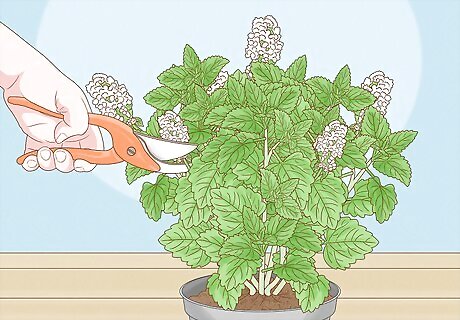
Shear and deadhead plants to promote new growth. After your plant's first flower blooms finish, remove the spent flowers. Shear back the plants by one-third to promote new growth and a new bloom of flowers. Remove any dead or dried leaves regularly. Shearing and deadheading plants will result in bushier plants that flower more consistently.
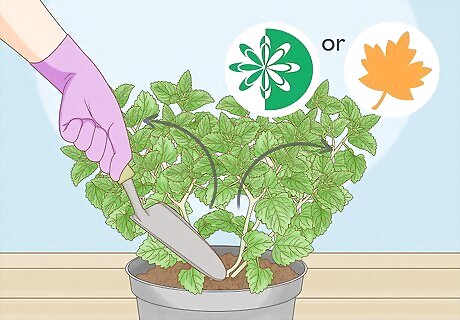
Divide root systems in the spring or fall. You can propagate, or make new plants, by dividing one plant’s root system. Dig up a cluster of plants with at least two to three stalks, or remove them from their pot if you used a container. Soak the root ball to the point of complete saturation. Use a clean trowel or garden knife to divide the root cluster in half, then replant each new plant. Continue to water frequently after you’ve divided the plants. Don’t let the root system dry out as you would with a normal catnip plant. Dividing plants can help control overgrowth, renew fading plants, or simply allow you to share a plant with a friend.
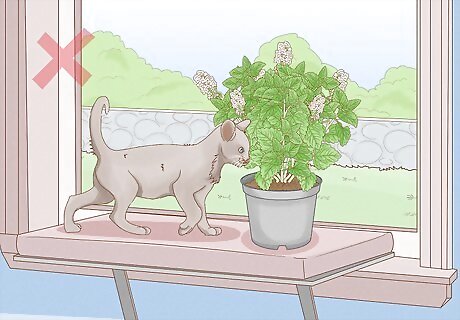
Keep your kitty from damaging it or nearby plants. Cats are of course attracted to catnip plants, and love to nip at their leaves and lay in plant beds. If you have an outdoor cat, don’t plant catnip next to delicate flowers or plants you wouldn’t want your cat to damage. If using containers, avoid positioning pots in places where they might easily be knocked over or broken. Consider using garden fencing, bracing, or bamboo sticks to support the plants and prevent your cat from laying on them.
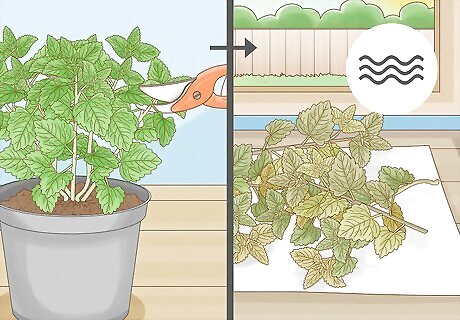
Harvest and air dry leaves. To harvest, trim down a stalk to its base, or just above a leaf joint, or cut off the whole plant at the base. Cutting just above a joint, or where a leaf or leaves spring from the stalk, will promote more rapid new growth. Air drying is the best drying method for preserving catnip leaves. Let your leaves sit out on a paper towel beneath a sunlit windowsill for two or three days. For whole plants, hang them upside down in a cool location for a few weeks. Do your best to keep your cat away from your drying leaves. Consider a room with a closed door to keep the cat from jumping up and getting into the leaves. Once they’ve dried, place them in an airtight container for storage.













Comments
0 comment